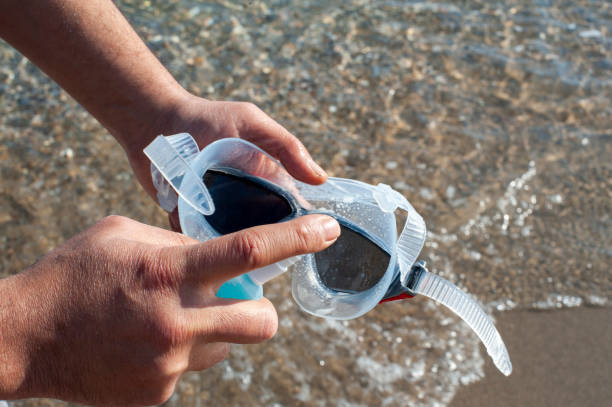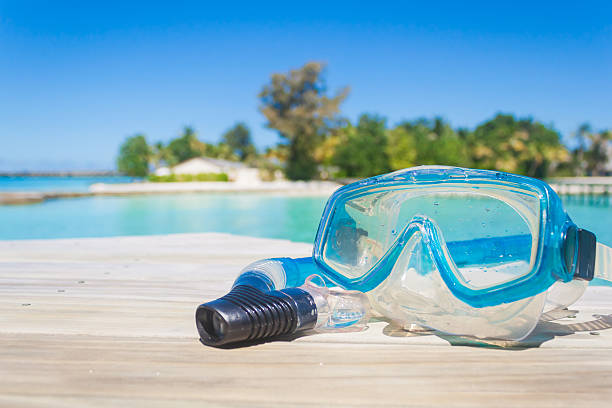أهلاً بكم في الدليل الشامل حول ماهية قبعة السباحة ولماذا تُعد من الإكسسوارات الأساسية للسباحين. انغمسوا في عالم قبعات السباحة، من لمحة عامة عنها إلى دورها المحوري في تحسين تجربة السباحة. اكتشفوا أهمية قبعات السباحة للسباحين من جميع المستويات، واكتشفوا أهمية اختيار قبعة السباحة المناسبة من شركة تصنيع قبعات سباحة مرموقة. دعونا نستكشف أسرار قبعات السباحة معًا!
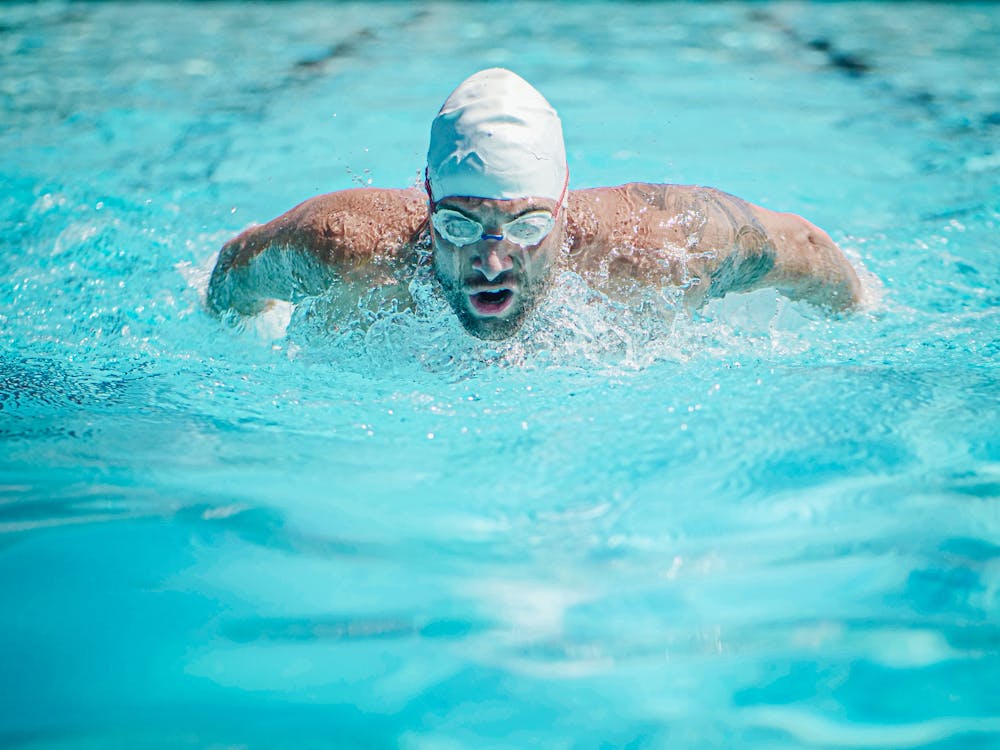
ما هي قبعة السباحة؟
أ قبعة السباحة قبعة سباحة مُجهزة، مصنوعة عادةً من السيليكون أو اللاتكس أو الليكرا، يرتديها السباحون لحماية شعرهم من الكلور، وتقليل مقاومة الماء، وتحسين ديناميكا الماء للسباحة بشكل أسرع. كما تُساعد على إبقاء الشعر بعيدًا عن الوجه ونظارات السباحة، مما يُعزز الرؤية والتركيز. أما بالنسبة للسباحين التنافسيين، فتُحسّن قبعات السباحة من انسيابية الرأس، مما يُقلل من مقاومة الماء ويُحسّن الأداء.
لكن إذا استكشفتَ أصولها، فستكتشف رحلةً آسرةً عبر الزمن. في أوائل القرن العشرين، كانت قبعات السباحة تُصنع من قماش مطاطي، مما يُشير إلى بداياتها المتواضعة. سرعان ما حوّلت هذه التصاميم الأولية قبعات السباحة إلى تصاميم أزياء مرغوبة، تعكس اتجاهات العصر المتطورة.
يعود تاريخ قبعات السباحة الحديثة إلى عام ١٨٨٣، عندما طُرح المطاط لأول مرة، مُحدثًا ثورة في معدات السباحة. وقد مهد الاستخدام المبتكر للمطاط الطريق لقبعات السباحة الأنيقة والعملية التي نعرفها اليوم. ومع مرور الوقت، شهدت هذه الملحقات الأساسية تقلبات في شعبيتها، إلا أن عمليتها وأسلوبها لا يزالان ثابتين.
منذ ظهورها في عشرينيات القرن الماضي وحتى تطورها إلى أشكال السيليكون واللاتكس المعاصرة، ظلت قبعات السباحة جزءًا لا يتجزأ من ثقافة السباحة. تجمع قبعات السباحة بين العملية والأناقة، ولا تزال تلعب دورًا حيويًا في تجارب السباحين، حيث تمزج بين التاريخ والابتكار بسلاسة.
ماذا يفعل غطاء السباحة؟
قبعة السباحة ضرورية للسباحين الذين يسعون لتحسين أدائهم في الماء. دعونا نتعمق في كيفية مساهمة قبعة السباحة في تحسين ديناميكا الماء وحماية شعرك أثناء جلسات السباحة.
الهيدروديناميكا
يُعد تحسين ديناميكا الماء من أهم فوائد ارتداء قبعة السباحة. فبتقليل مقاومة الماء، قبعات السباحة تساعدك على الانزلاق بسلاسة في كل ضربة، مما يُحسّن سرعتك وكفاءتك. أظهرت الدراسات البحثية أن بعض نماذج قبعات السباحة تُقلل بشكل ملحوظ من السحب السلبي، مما يمنحك أفضلية تنافسية في المسبح.
تقليل السحب
من أهم وظائف قبعة السباحة تقليل المقاومة أثناء السباحة. فالتصميم الأنيق لقبعات السباحة الحديثة يُقلل من الاضطراب حول رأسك، مما يسمح لك بالحفاظ على قوة الدفع مع كل ضربة. هذا الانخفاض في المقاومة لا يزيد من سرعتك فحسب، بل يُوفر أيضًا الطاقة أثناء السباحة لفترات أطول.
تحسين السرعة
مع انخفاض مقاومة الماء، تزداد السرعة. بفضل انسيابية رأسك وشعرك، تُمكّنك قبعة السباحة المُناسبة من اختراق الماء بكفاءة أكبر. سواء كنت تُسابق الزمن أو تهدف فقط إلى تحسين أوقاتك في اللفة، فإن دمج قبعة السباحة مع معداتك يُحدث فرقًا ملحوظًا في سرعة تجولك في المسبح.
حماية الشعر
بالإضافة إلى مزاياها الهيدروديناميكية، تُعدّ قبعة السباحة حاجزًا واقيًا لشعرك من المواد الكيميائية القاسية في حمامات السباحة والعوامل البيئية. إن فهم كيفية حماية قبعات السباحة لشعرك يُساعدك في الحفاظ على صحته ومظهره طوال فترة السباحة.
منع أضرار الكلور
يُستخدم الكلور عادةً لتعقيم مياه المسابح، ولكنه قد يضر بصحة الشعر إذا تُرك دون علاج. تعمل قبعة السباحة عالية الجودة كدرع، فتمنع الكلور من ملامسة خصلات شعركِ مباشرةً وتشبعها. من خلال إنشاء حاجز بين شعركِ ومياه المكلور، تساعد قبعات السباحة على الحفاظ على رطوبة الشعر وتقليل خطر الجفاف أو تغير اللون.
إبعاد الشعر عن الوجه
بالإضافة إلى الحماية الكيميائية، يُحافظ ارتداء قبعة السباحة على شعركِ منسدلًا أثناء السباحة. قد تُشتت خصلات الشعر المتناثرة انتباهكِ أثناء التمرين أو السباقات، مما يؤثر على راحتكِ وتركيزكِ. بحماية شعركِ من التشابك، تضمن قبعات السباحة عدم إعاقة رؤيتكِ أو عرقلة حركتكِ.
من ماذا تصنع قبعات السباحة؟
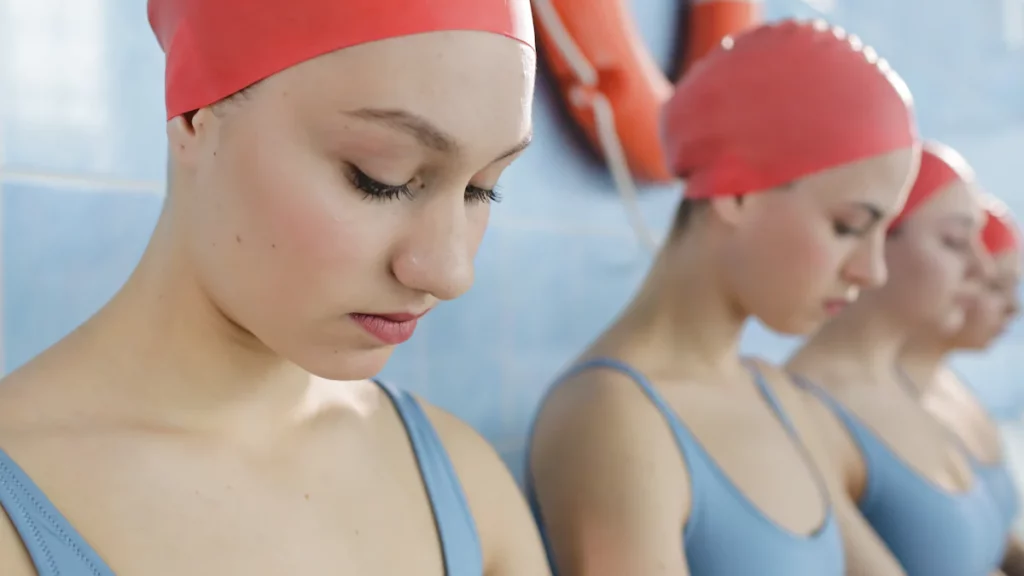
عمومًا، تُصنع قبعات السباحة من مواد متنوعة، مثل السيليكون واللاتكس والليكرا، وغيرها. لكل مادة وظائفها الخاصة واستخداماتها المختلفة. دعونا نستكشف خصائصها.
أغطية السيليكون
قبعات السباحة السيليكونية خيار مثالي للسباحين الباحثين عن المتانة والراحة. هل تشعرين بالقلق من تلف شعركِ أو تشابك قبعتكِ بسبب الكلور؟ قبعات السيليكون هي الحل الأمثل. فهي تحمي شعركِ من أضرار الكلور، كما أنها ملائمة تمامًا، مما يجعلها مثالية لجلسات السباحة المنتظمة.
من أفضل مزايا قبعات السباحة المصنوعة من السيليكون متانتها. فهي تتحمل الاستخدام المكثف مع الحفاظ على شكلها ومرونتها. سواء كنت تغوص في المسبح كسباح محترف أو تستمتع بغطسة عادية، ستبقى معك قبعة السيليكون طوال جلسات السباحة العديدة دون أن تبلى. ستشعر وكأنك تمتلك رفيقًا موثوقًا به في كل مرة تسبح فيها.
ولنتحدث عن ذلك الملاءمة الناعمة. تتكيف أغطية السيليكون بشكل مريح مع رأسك، مما يمنحك شعورًا بالأمان والانسيابية. تخيلها كطبقة ثانية من الجلد تُمكّنك من الانزلاق في الماء بسلاسة. مع غطاء سيليكون مُحكم، يمكنك نسيان المشتتات والتركيز على ضرباتك. الهدف هو تحسين أدائك وجعل سباحتك ممتعة قدر الإمكان. لذا، في المرة القادمة التي تستعد فيها للسباحة، ارتدِ غطاء سيليكون وجرّب الفرق.
أغطية اللاتكس
إذا كنت سباحًا تبحث عن قبعة خفيفة الوزن ومريحة، فإن قبعات السباحة المصنوعة من اللاتكس هي الخيار الأمثل. فهي توفر شعورًا بالراحة مع إحكام مثالي حول رأسك. تخيل ارتداء قبعة تشعرك وكأنك جلدك الثاني - ببساطة، ملاءمة مثالية تدوم طويلًا.
من أفضل مزايا قبعات السباحة المصنوعة من اللاتكس مرونتها. فهي تتمدد بسهولة، مما يمنحك مقاسًا مخصصًا يناسبك ويحافظ على ثباته طوال فترة السباحة. ستشعر وكأنك ترتدي قبعة مصممة خصيصًا لرأسك. تضمن هذه المرونة الراحة والعملية، لتتمكن من الغوص دون القلق من انزلاق قبعتك أو الشعور بضيقها.
هل شعرك قصير؟ قبعات السباحة المصنوعة من اللاتكس هي خيارك الأمثل. تصميمها المريح يُبقي شعرك منسدلاً بشكل أنيق، مما يُقلل من الاحتكاك ويساعدك على الانزلاق بسلاسة في الماء. إذا كنت تبحث عن السرعة وخفة الحركة، فإن قبعة السباحة المصنوعة من اللاتكس هي ما تحتاجه تمامًا. اعتبرها سلاحك السري لاختراق الماء كالدلافين. مع قبعة السباحة المصنوعة من اللاتكس، يمكنك التركيز على أدائك وتجنّب عناء تصفيف شعرك.
قبعات الليكرا
قبعات السباحة المصنوعة من الليكرا، المصممة لتوفير الراحة والأداء، تُضفي فوائد فريدة على حمام السباحة. تحمي هذه القبعات الناعمة والمريحة شعرك من المواد الكيميائية في حمام السباحة مع تقليل مقاومة الماء. إذا كنت تبحث عن قبعة تجمع بين الراحة والكفاءة، فإن قبعات الليكرا خيار رائع.
قبعات السباحة المصنوعة من الليكرا تُضفي الراحة. خامتها الناعمة تُشعرك بلطف على بشرتك، مما يجعلها مثالية لجلسات التدريب الطويلة أو السباحة الهادئة على الشاطئ. تخيل قبعة تُشعرك وكأنك ترتدي قبعتك المريحة المفضلة - مصممة خصيصًا للماء. يمكنك ارتداؤها لساعات دون أي شعور بعدم الراحة.
على عكس قبعات السيليكون أو اللاتكس، توفر قبعات السباحة المصنوعة من الليكرا ملاءمةً أكثر مرونةً حول رأسك. يمنحك هذا التصميم المريح تجربةً أكثر راحةً دون التضحية بالأداء. ستشعر وكأنك ترتدي قبعةً مريحةً وجيدة التهوية، لكنها في الوقت نفسه تساعدك على الانزلاق في الماء. إذا كنت ترغب في الاستمتاع بالسباحة دون ضغط القبعات الضيقة، فإن الليكرا هو الخيار الأمثل.
ما هي مدة صلاحية قبعات السباحة؟ عاملان يؤثران على عمرها الافتراضي
يختلف عمر قبعات السباحة بناءً على عدة عوامل، أهمها نوع المادة المستخدمة وتكرار استخدامها. إن فهم كيفية تأثير هذه العوامل على المتانة يساعد السباحين على اتخاذ قرارات مدروسة وإطالة عمر معداتهم. دعونا نتعمق في كيفية تأثير كل عامل على عمر قبعات السباحة.
نوع المادة
يعتمد عمر قبعة السباحة بشكل كبير على مادتها. قبعات اللاتكس، على الرغم من سعرها المناسب ومرونتها، تميل إلى التآكل بسرعة، حيث تدوم عادةً لمدة شهر إلى شهرين مع الاستخدام المنتظم. قبعات السيليكون، المعروفة بمتانتها، يمكن أن تدوم لمدة تصل إلى عام أو أكثر مع الصيانة المناسبة. قبعات الليكرا، على الرغم من راحتها، عادةً ما يكون عمرها الافتراضي أقصر نظرًا لطبيعة نسيجها، وغالبًا ما تتآكل بعد بضعة أشهر من الاستخدام المتواصل. وفقًا لموقع SwimOutlet.com، تُعد قبعات السيليكون الخيار الأمثل لإطالة العمر، خاصةً للسباحين المحترفين الذين يحتاجون إلى معدات متينة تتحمل الاستخدام المتكرر والمواد الكيميائية القاسية في حمامات السباحة.
تردد الاستخدام
يلعب تكرار استخدام قبعة السباحة دورًا حاسمًا في عمرها الافتراضي. يلاحظ السباحون اليوميون التآكل والتلف أسرع من أولئك الذين يسبحون بضع مرات أسبوعيًا. على سبيل المثال، قد تحتاج قبعة اللاتكس المستخدمة يوميًا إلى استبدال كل شهر، بينما قد تدوم قبعة السيليكون في نفس الظروف لعدة أشهر. لإطالة عمر قبعة السباحة، يُنصح بشطفها بالماء العذب بعد كل استخدام وتركها تجف تمامًا قبل تخزينها بعيدًا عن أشعة الشمس المباشرة. وفقًا لجمعية السباحة الأمريكية، فإن العناية المناسبة والاستخدام المعتدل يُساعدان على إطالة عمر قبعات السباحة، مما يضمن بقائها فعالة ومريحة لفترات أطول.
كيفية الحفاظ على قبعات السباحة؟
الصيانة الجيدة أساسية لإطالة عمر قبعة السباحة. باتباع بعض الخطوات البسيطة، كالشطف بعد الاستخدام والتخزين السليم، يمكنك ضمان بقاء قبعة السباحة الخاصة بك فعالة ومتينة لفترات أطول.
الشطف بعد الاستخدام
بعد كل جلسة سباحة، من الضروري شطف قبعة السباحة جيدًا بالماء العذب. يساعد ذلك على إزالة الكلور والملح والمواد الكيميائية الأخرى الموجودة في المسبح والتي قد تُتلفها مع مرور الوقت. ووفقًا لخبراء Swim England، فإن شطف قبعات السباحة فور استخدامها يُطيل عمرها بشكل ملحوظ عن طريق منع تراكم المواد الكيميائية وتقليل الروائح الكريهة. ببساطة، اشطف الغطاء تحت الماء البارد واعصره برفق للتخلص من الماء الزائد قبل تجفيفه بالهواء.
التخزين السليم
تجنب تعريضها لأشعة الشمس المباشرة أو درجات الحرارة العالية، فقد يُضعف ذلك مادة الغطاء. خزّنها في مكان بارد وجاف بعيدًا عن مصادر الحرارة. يُساعد تعليقها أو فردها لتجف تمامًا قبل التخزين على الحفاظ على شكلها ومرونتها. اتباع هذه الممارسات يضمن بقاء غطاء السباحة الخاص بك فعالًا ومريحًا لرحلات السباحة القادمة.
ما هي قبعة السباحة التي تحافظ على جفاف الشعر؟
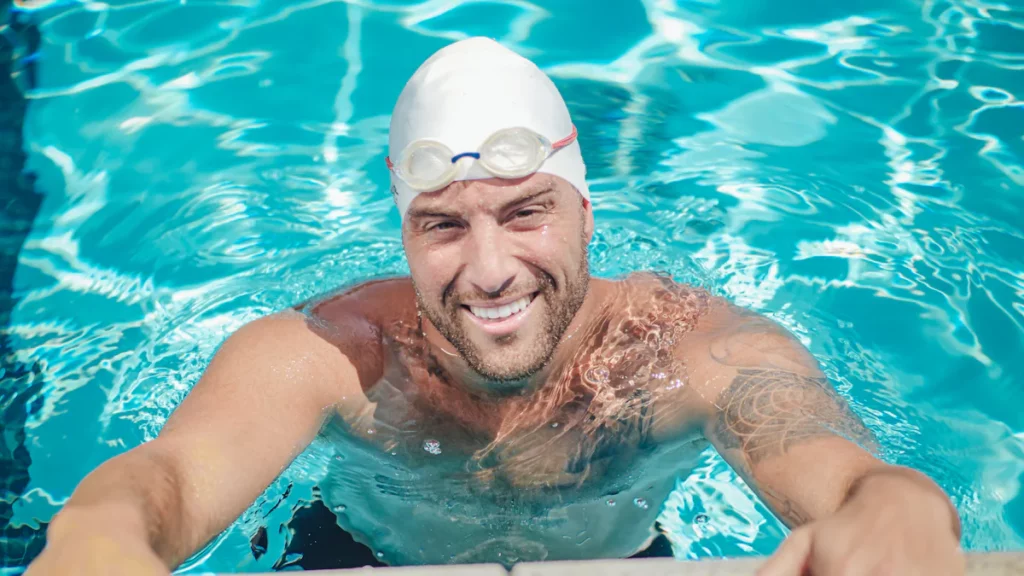
عندما يتعلق الأمر بالحفاظ على جفاف الشعر، ليست كل قبعات السباحة متساوية. مع أن أي قبعة سباحة لا تضمن جفافًا كاملًا، إلا أن بعض الأنواع توفر حماية أفضل من تسرب الماء. إليك ما تحتاجين معرفته لاختيار أفضل قبعة سباحة للحفاظ على جفاف شعرك قدر الإمكان.
قبعات السباحة المصنوعة من السيليكون
تُعتبر قبعات السباحة المصنوعة من السيليكون الخيار الأمثل للحفاظ على جفاف الشعر. فخامتها السميكة وغير المسامية تُوفر إحكامًا حول الرأس، مما يُقلل بشكل كبير من كمية الماء التي قد تتسرب. ووفقًا لموقع SwimOutlet.com، تُعتبر قبعات السيليكون الخيار الأمثل للسباحين المحترفين الذين يحتاجون إلى قبعة متينة تُقلل من تسرب الماء. كما أن ملاءمتها المُحكمة ومتانتها تجعلان قبعات السيليكون أكثر فعالية في الحفاظ على جفاف الشعر مُقارنةً ببدائل اللاتكس أو الليكرا.
أغطية مزدوجة
للسباحين المهتمين بالحفاظ على جفاف شعرهم، يُمكن أن يُحدث ارتداء قبعتي سباحة نقلة نوعية. تتضمن هذه التقنية ارتداء غطاء من الليكرا أو اللاتكس أسفل غطاء من السيليكون. يوفر الغطاء الداخلي ملاءمة مريحة ويساعد على تثبيت أي شعر متطاير، بينما يُوفر غطاء السيليكون الخارجي عزلًا مُحكمًا للماء. يُوفر هذا المزيج طبقة إضافية من الحماية ضد تغلغل الماء. غالبًا ما يستخدم السباحون المحترفون هذه الطريقة أثناء التدريب والمسابقات لزيادة جفاف الشعر.
نصائح إضافية
إلى جانب اختيار الغطاء المناسب، يُعدّ ضمان ملاءمته أمرًا بالغ الأهمية. تأكد من أن الغطاء يغطي أذنيك ومنبت شعرك بالكامل. كما يضع بعض السباحين طبقة رقيقة من الفازلين حول حواف الغطاء لتعزيز إحكامه. مع ذلك، توخَّ الحذر عند استخدام هذه الطريقة لأنها قد تُتلف المادة بمرور الوقت.
تعليقات من السباحين
أستخدم قبعات السباحة المصنوعة من السيليكون منذ سنوات، وقد أحدثت فرقًا كبيرًا في الحفاظ على جفاف شعري أثناء السباحة. يُحدث التصميم المريح وجودة المادة فرقًا ملحوظًا في تقليل تعرضي للماء.
لقد حسّنت قبعات السباحة ذات الطبقتين تجربتي في السباحة بشكل ملحوظ، إذ وفرت حماية إضافية لشعري الطويل. لم أعد أقلق بشأن تأثير الرطوبة الزائدة على أدائي في المسبح.
هل من الأفضل وضع قبعة السباحة على الشعر المبلل أم الجاف؟
عند ارتداء قبعة السباحة، غالبًا ما يختلف السباحون حول ما إذا كان من الأفضل البدء بشعر مبلل أم جاف. لكلٍّ من الطريقتين مزاياها، ويعتمد الاختيار بشكل كبير على التفضيل الشخصي، ونوع قبعة السباحة، والظروف الخاصة. سنستعرض هنا مزايا وعيوب كلا الطريقتين لمساعدتك على اتخاذ قرار واعٍ.
فوائد وضع قبعة السباحة على الشعر المبلل:
- تطبيق أسهل: ترطيب الشعر قبل ارتداء قبعة السباحة يُسهّل عملية السباحة. يُقلّل الماء الاحتكاك، مما يسمح للقبعة بالانزلاق بسهولة أكبر دون شد الشعر أو تشابكه. هذا مفيدٌ بشكل خاص للسباحين ذوي الشعر الطويل أو الكثيف.
- ملاءمة أفضل: يساعد الشعر المبلل على التصاق قبعة السباحة بفروة رأسك بشكل أفضل، مما يُضفي عليها ملاءمةً مُحكمة. هذا مُفيدٌ بشكل خاص لقبعات السيليكون واللاتكس، المُصممة لتكون مُحكمة ومُلائمة للجسم. يُحسّن هذا الالتصاق المُحكم ديناميكيات الماء بتقليل السحب في الماء.
- تقليل الضرر: لأصحاب الشعر الجاف أو المتقصف، يُقلل ترطيب الشعر قبل ارتداء قبعة السباحة من خطر تكسره. فالشعر الجاف أكثر عرضة للتكسر، والاحتكاك الناتج عن قبعة السباحة قد يُفاقم هذه المشكلة.
- راحة: يجد العديد من السباحين أن ارتداء قبعة السباحة على الشعر المبلل أكثر راحة. فالماء يعمل كمزلق، مما يمنع القبعة من أن تصبح ضيقة أو غير مريحة. وهذا مهم بشكل خاص خلال جلسات السباحة الطويلة أو المسابقات.
مساوئ وضع قبعة السباحة على الشعر المبلل:
- تسرب المياه: مع أن الشعر المبلل يُحسّن الملاءمة والراحة، إلا أنه قد يسمح للماء بالتسرب إلى القبعة بسهولة أكبر. قد لا يكون هذا مثاليًا للسباحين الذين يُفضلون إبقاء شعرهم جافًا قدر الإمكان.
- امتصاص الكلور: قد يؤدي تبليل الشعر قبل السباحة إلى امتصاصه كمية أكبر من الكلور من مياه المسبح. مع أن قبعات السباحة توفر بعض الحماية، إلا أنها ليست مقاومة للماء تمامًا، ويمكن للشعر المبلل أن يمتص الماء المكلور، مما قد يؤدي إلى تلفه مع مرور الوقت.
فوائد وضع قبعة السباحة على الشعر الجاف:
- امتصاص أقل للكلور: وضع قبعة سباحة على الشعر الجاف يُساعد على تقليل امتصاص الكلور. فالشعر الجاف أقل عرضة لامتصاص مياه المسبح، مما يُساعد على الحفاظ على صحة الشعر ومنع تلفه بسبب الكلور.
- التحضير السريع: للسباحين المستعجلين، يُوفّر وضع قبعة سباحة على الشعر الجافّ الوقت. لا حاجة لتبليل الشعر أولاً، مما يُوفّر الوقت أثناء الاستعدادات المُستعجلة قبل السباحة.
- إمكانية الحصول على ختم أفضل: يجد بعض السباحين أن ارتداء قبعة سباحة جافة على شعر جاف يُعزز عزل الشعر، ويمنع دخول المزيد من الماء. يُعد هذا مفيدًا بشكل خاص لمن يرغبون في الحفاظ على جفاف شعرهم قدر الإمكان أثناء السباحة.
مساوئ وضع قبعة السباحة على الشعر الجاف:
- تطبيق صعب: قد يكون وضع قبعة السباحة على الشعر الجاف أكثر صعوبة. فنقص الترطيب الناتج عن الماء يعني أن القبعة قد تلتصق بالشعر وتشده، مما يجعل العملية غير مريحة وربما مؤلمة.
- مشاكل الملاءمة: قد يُصعّب جفاف الشعر الحصول على ملاءمة مُحكمة وانسيابية. قد لا يلتصق الغطاء بفروة الرأس جيدًا، مما يؤدي إلى زيادة السحب وانخفاض الكفاءة الهيدروديناميكية في الماء.
- زيادة الاحتكاك: يمكن أن يسبب الشعر الجاف المزيد من الاحتكاك عند ارتداء قبعة السباحة، مما قد يؤدي إلى تكسر الشعر، وخاصة بالنسبة لأولئك الذين لديهم شعر طويل أو كثيف.
خاتمة
في الختام، إن فهم ماهية قبعة السباحة وكيفية صيانتها يُحسّن تجربة السباحة بشكل كبير. تُقدم قبعات السباحة، سواءً كانت مصنوعة من السيليكون أو اللاتكس أو الليكرا، فوائد مُتعددة، مثل حماية الشعر من الكلور وتقليل الاحتكاك. كما أن العناية الجيدة، بما في ذلك الشطف بعد الاستخدام والتخزين الجيد، تُطيل عمر قبعتك. مع أن أي قبعة سباحة لا تُحافظ على جفاف الشعر تمامًا، إلا أن اختيار النوع المناسب وضمان المقاس المُناسب يُقلل بشكل كبير من تعرض الشعر للماء. استمتع بجلسات سباحة أكثر فعالية وراحة باختيار قبعة السباحة الخاصة بك وصيانتها بعناية.
التعليمات
س1: كيفية وضع قبعة السباحة بشكل صحيح؟
لارتداء قبعة السباحة بشكل صحيح، افتحها بكلتا يديك، مع التأكد من أن أصابعك داخلها. انحنِ للأمام وضع مقدمة القبعة على جبهتك، ثم اسحبها فوق رأسك باتجاه الخلف. اضبط القبعة لتغطية أذنيك ومنبت شعرك، مع تنعيم أي تجاعيد لضمان ملاءمتها بشكل محكم.
س2: كيف أعرف حجم قبعة السباحة التي يجب أن أشتريها؟
تتوفر معظم قبعات السباحة بمقاسات قياسية، لكن بعض العلامات التجارية، مثل فانجارد، تقدم مقاسات مختلفة للأطفال والكبار. لتحديد المقاس المناسب، قس محيط رأسك فوق أذنيك مباشرةً وقارنه بجدول المقاسات المقدم من الشركة المصنعة. يجب أن تكون القبعة الملائمة محكمة الغلق، ولكن ليست ضيقة جدًا.
س3: ما الذي يجب أن أبحث عنه في قبعة السباحة؟
عند اختيار قبعة سباحة، ضع في اعتبارك نوع المادة (سيليكون، لاتكس، أو لايكرا)، وراحتك، واحتياجاتك في السباحة. قبعات السيليكون متينة وتوفر ملاءمة محكمة، بينما قبعات اللاتكس خفيفة الوزن ومرنة، بينما توفر قبعات الليكرا الراحة مع ملاءمة أوسع. ابحث أيضًا عن ميزات مثل الحماية من الأشعة فوق البنفسجية أو التصميم المريح لمزيد من المزايا.
س4: ما مدى إحكام قبعة السباحة؟
يجب أن تكون قبعة السباحة محكمة بما يكفي لتثبيتها بإحكام على رأسك دون انزلاق، ولكن ليس لدرجة أن تسبب لك إزعاجًا أو صداعًا. يجب أن تغطي شعرك وأذنيك بالكامل، وأن تخلق سطحًا أملسًا وانسيابيًا لتقليل السحب في الماء. التوازن الجيد بين الراحة والدفء هو الأساس.
س5: هل يجب أن تغطي قبعة السباحة أذنيك؟
نعم، يجب أن تغطي قبعة السباحة أذنيك لضمان ثباتها وتقليل السحب في الماء. كما أن تغطية أذنيك تساعد على منع دخول الماء، وتحمي أذنيك من المواد الكيميائية في حمام السباحة، وتقلل من احتمالية التهابات الأذن. بالإضافة إلى ذلك، تمنع تشابك شعرك في نظارات السباحة، وتُحسّن من ديناميكا الماء بشكل عام.
